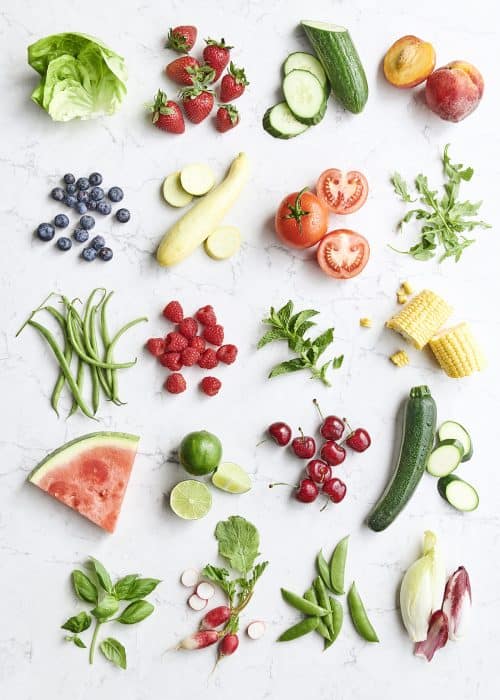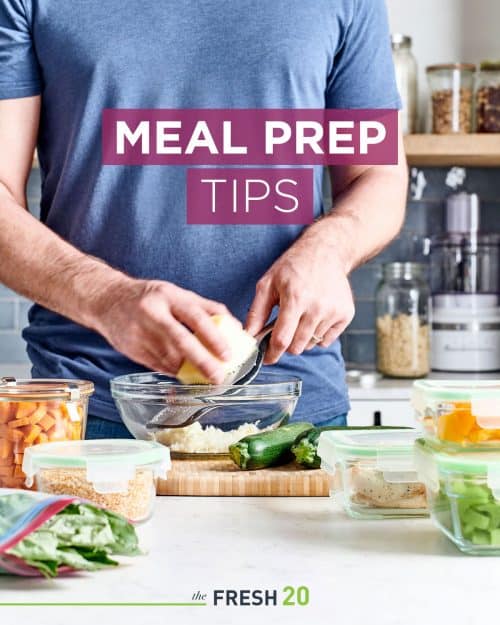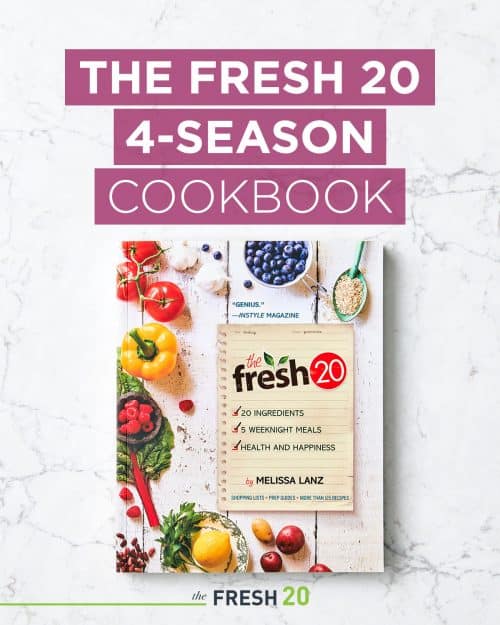Summer is our favorite time of year to take advantage of the freshest seasonal fruits and vegetables that are bursting with flavor. Here’s our top 20 list of the best fruits and vegetables for the summer season, including ripe tomatoes, juicy peaches and sweet corn. It’s a fresh guide to summer produce to help you get the most flavor into your recipes with tips on how to store and cook them!

Arugula
Arugula is a pungent green leaf plant popular in Italian cooking. It has an earthy, peppery taste with mustard undertones. Mature arugula leaves can be somewhat bitter. Arugula is grown year round but it’s peak is in the summer months.
Arugula is high in antioxidants and has many health benefits contributing to weight loss, vibrant skin and boosting the immune system.
Typically, arugula is prepared as a salad with a citrus based dressing but it also works well as an addition to pasta and sandwiches.
Basil
Basil is a popular aromatic herb related to mint. There are dozens of types of basil plants ranging from small leaf varieties to large purple leaf plants. Basil has a sweet flavor.
Basil is best known for pesto and caprese salad but it is an important healing agent used by many as an essential oil or basil extract.
One of the most widely used herbs, basil comes in many varieties from sweet to spicy, blue to green, flat to ruffled. Like other fresh herbs, basil is best added at the very end of cooking, or as a garnish, where it’s fresh vibrant flavor won’t be destroyed by heat. There are HUNDREDS of uses for basil, think way beyond Italian cooking and heavy sauces. Add fresh basil leaves to lemonade, cocktails, gazpacho, shortbread cookies, compound butters, breads, salad dressings or of course, pesto!
Another easy to grow herb, store freshly picked basil in a small glass of water like a bouquet of flowers. Cover the leaves loosely with a bag and let it sit on your counter, basil hates the cold so refrigerating is a no-no.
Bibb Lettuce
Boston Bibb lettuce is the gold standard of butterhead lettuce varieties. The outer leaves are green, wide and soft while the inner leaves are lighter in color and firmer in texture. Bibb lettuce has a mild, sweet flavor.
Boston Bibb lettuce provides calcium, magnesium, phosphorus, and potassium and is a good source of vitamins A and K.
It’s a great addition to any sandwich and the outer leaves make the perfect gluten free taco wrap.
Blueberries
Sometimes being #2 is amazing! Following strawberries, blueberries are the second most popular berry in the United States. As one of the few fruits that are native to North America, blueberries are definitely in the superfood category with high fiber, Vitamin C, Manganese, and only 85 fat free calories per cup!
Fresh berries are at their peak June through August. At the market choose ones that are firm, dry, and are completely deep blue (a silver tinge is ok, no red) since they do not ripen after harvest. When you get your berries home protect them from the getting squashed in the refrigerator by storing in a sturdy covered container. Don’t wash before refrigerating! Blueberries freeze beautifully – just put in a single layer on a baking sheet and freeze until firm (about 1-2 hours). Transfer to a freezer bag or container for storage or enjoy them straight from the freezer for a refreshing snack!
Cherries
Choosing cherries is pretty simple, and they freeze exceptionally well, so when you find a sale buy a bunch and enjoy! At the market you will most likely see two types of cherries; plain red and Rainier. The typical red cherry should be a deep red color with a green (not brown) stem, and smooth unwrinkled skin. Rainier cherries are not solid red, but have a yellow/pink/blush color and are not quite as firm as a red. When you get your cherries home be sure to refrigerate them unwashed to extend their freshness. Wash cherries just before you eat them – otherwise they can absorb too much water and lose that perfect crispness.
Cucumbers
How can one little gourd have so many amazing properties? The cucumber, in addition to being full of Vitamins A, B, C & K, is reported to reduce the risk of cardiovascular disease, improve the skin, detoxify the body, aid in digestion, and alkalize the blood. And, since they are 90% water, cucumbers keep us hydrated and flush out toxins. Like other veggies, bigger is NOT better when it comes to choosing cucumbers. Smaller cucumbers have smaller seeds and tend to be crisper – look for uniform firmness, consistent deep color, and no spots. When stored in the crisper they should last up to a week. If you find cucumbers to be bitter, try choosing an English or seedless variety. They are a bit more expensive but their lack of large seeds makes them more palatable.
Corn
Ahhh, one of the best parts of summer – Saturday mornings at the farmers market picking out sweet fresh corn. But in the giant bins overflowing with it, how do you choose the best ones without stripping off the husks (a definite no no)? First, start by choosing ears with fresh green husks and light gold silks. If the husk is dried out or the silks are darkening, move on to the next ear. You can feel the tassel end of the ear to see if the kernels underneath are plump – resist the urge to peek! Also check for tiny holes which may indicate the presence of worms. If you just aren’t sure you can bet the farm stand workers will be happy to assist. Hate removing those sticky strings after the husk is removed? Try lightly brushing them away with a dish brush or gently rubbing them off with a clean damp cloth.
Green Beans
One of the most common and kid friendly vegetables, green beans are high in fiber, vitamins, calcium, potassium, and iron. Known as string beans, snap beans, or Haricot Verts, green beans are the young unripe fruit and pod of bean plants. While there are over 100 varieties ranging from green to yellow to purple, the key to green beans popularity is their versatility and mild flavor. The can be quickly blanched and served with other cold veggies, or they can be boiled, sautéed, roasted, or added to soups and stews. To store, put unwashed beans in a plastic bag or container and store in the crisper for up to a week. To use simply trim any dry or browned ends and snap into bite sized pieces!
Lime
Like other citrus fruits, limes are good for heart health and very high in Vitamin C (one lime has ⅓ of your daily requirement) which helps the body absorb iron. They should have bright green color, avoid yellowish color or brown spots – those indicate age. A slight give when squeezed is a sign of ripeness, if it’s too firm it probably won’t be very juicy. Like lemons, they store up to a month in your refrigerator so they are ok to stock up on. Lime pairs well with Mexican cuisine, heavily spiced dishes, and sweet fruits.
Oh, and margaritas!
Mint
What do mint and zucchini have in common? Abundance! Once they hit their peak growing season stand back and have your recipes at the ready.
Mint is easy to grow at home in pots – a fun project for kids since it has a great aroma and familiar flavor. It can be invasive so use caution when planting in your garden! Peppermint has a long history of medicinal uses, many find it soothes stomach discomforts and helps with colds. Spearmint is mostly favored for culinary uses such as savory and sweet dishes, cold drinks, and teas. Fresh mint should be stored wrapped loosely in damp (not wet) paper towels in a bag or resealable container in the refrigerator.
Peaches
Like other stone fruits (nectarines, plums, cherries), peaches are high in Vitamins A & C, potassium, and fiber. For many, the arrival of peaches signals the true start of summer. Peaches are one of the few fruits that ripen after picking, so leave them on the counter until they are soft and fragrant, then store in the refrigerator for a few days. The easiest way to choose a ripe peach is to gently press around the stem area, if it has a bit of give it’s close to ripeness. Color isn’t a good indicator because there are many varieties with different colorations.
Radicchio
A member of the chicory family, radicchio is a beautiful leafy vegetable that is often used in Italian cuisine. Most notable for its deep wine colored leaves and bitter flavor, radicchio is high in B vitamins, Vitamin C, as well as copper, iron and zinc. When buying radicchio choose tight, compact heads with vibrant red leaves, white ribs, and no visible blemishes. It stores well in the refrigerator for over a week just keep it in the crisper drawer and don’t wash it until ready to use. Because of its bitter flavor, radicchio is best mixed with other greens if used raw, or slightly mellowed by grilling or sautéing.
Radish
An edible root vegetable, radishes are related to kale, broccoli, cauliflower, and horseradish. They are often eaten raw in salad or on a crudité platter, but when sautéed they soften and loose a bit of that spicy bite. If you’re a fan of the crunch, radishes are great pickled – there are lots of easy recipes available online. Choose firm bright radishes with heathy green leaves, if you plan on storing them for a while it may be best to trim off the leaves and seal the roots in a plastic bag.
Raspberries
Delicious AND great for your health – we love raspberries! These delicate berries are full of fiber and Vitamin C, but it’s their sweet-tart flavor that makes them a summertime favorite. The one downside of raspberries is their VERY short shelf life, they keep only a day or two in the refrigerator. If you want to keep them longer, arrange in a single layer on a baking sheet and freeze a few hours. Once frozen transfer to a storage bag, tightly seal, a keep frozen up to a year. Raspberries are perfect for topping yogurt or ice cream, adding to smoothies, dropping into lemonade, or making into a delicious sauce for savory dishes.
Sugar Snap Peas
Any veggie with ‘sugar’ in its name is sure to help entice even the pickiest eater. Sugar snap peas are sweet and tender and because the entire pea (pod too) is edible, they are great raw. As with other sweet veggies, simple preparations are the best way to showcase snap peas flavor; a quick sauté in olive oil with a sprinkle of salt and pepper is all you need to enjoy their fresh summer flavor.
Summer Squash
If you’ve been visiting your local farmers market lately (and please do!), you’ve no doubt seen bins and baskets full of beautiful summer squash and zucchini. Summer squash, which are harvested while immature, so the rinds are edible, are a great choice for versatility and nutrition. Their thin skins mean they can be eaten raw or cooked, however, it also means they have a short shelf life.
The popularity of the Paleo diet’s non-pasta noodles has now crossed over to mainstream cuisine. There are many videos online that show how to transform one squash or zucchini into a pile of healthy (gluten free) noodles – and it’s a fun way to get your kids into the kitchen.
As with most fresh produce, choose squash that are heavy for their size, free of blemishes and soft spots, and have deep consistent color. You don’t need to choose the prize winning foot long squash either, go for small to medium sized (think 6-8”) ones – they will have the best crunch, flavor, and less seeds. Store for no more than a few days in the refrigerator for the best flavor.
Strawberries
SUPERFOOD!
- Strawberries are in the top 5 fruits for antioxidant capacity
- High in vitamin C and fiber, free of sodium, fat and cholesterol
- Low in calories; 1 cup sliced strawberries has around 50 calories
CHOOSING
- Medium-sized strawberries are often more flavorful than giant ones
- Should be a vibrant, consistent red color with bright shiny green caps
- Avoid strawberries that have seedy tips or white around the cap
- For best flavor, serve strawberries at room temperature
STORING
- Very perishable, purchase a few days before using
- Once picked they do not continue to ripen so what you see is what you get!
- Store in refrigerator, in their original package, once you get them home, storing at room temperature will cause them to spoil faster
- Should keep for 3-5 days in your refrigerator if properly stored
- Strawberries should not be washed until right before using
Tomato
Few things can ruin a delicious dinner faster than bland, tasteless produce. Vibrant, flavorful tomatoes can be particularly difficult to find in the off season. Here are a few tips to help you choose the best your market has to offer:
BUY LOCALLY GROWN PRODUCE! Not only are you supporting local farmers, shorter transit times mean fresher goods that haven’t lost valuable nutrients sitting on pallets in a warehouse.
Don’t manhandle the tomatoes! Smelling the stem end and evaluating the skin for color and bruising are sufficient for evaluating freshness·
Tomatoes on the vine are a good choice if you’re having trouble deciding what to pick. These are often the freshest choice and the color and condition of the vine are also a good indicator of quality
Our best advice? Don’t refrigerate your tomatoes! Leave them on the counter out of direct sun for the best flavor and use them as soon as possible.
Watermelon
Choosing a ripe watermelon can be tricky – the farmers market is always your best bet, but if you are at your local market here is what to look for:
- A pale area where the watermelon lay on the ground as it grew – if the area is yellow that’s the best – it means the melon was allowed to stay on the vine to ripen. White is ok, but if the melon is green all round with no pale area – skip it and move on – it was picked too early.
- Like most fruit – it should feel heavy for its size. If in doubt, pick up two similar sized melons- the heavier one will be juicier.
- Consistent deep green color (except for the one pale spot)
- Unless you really know what you’re doing – don’t thump!
Once you get the melon home you can store in the refrigerator for a few days, but it will be at its juicy best if used right away. Melons do continue to ripen a little bit after being picked so they can be left on the counter if you suspect it’s under ripe.
Zuchinni
Zucchini is a great choice for versatility and nutrition. One zucchini provides nearly half your daily value of vitamin C and a ton of potassium – all while being extremely low in calories!
The popularity of zucchini ‘noodles’ in the Paleo diet has now crossed over to mainstream cuisine. There are many videos online that show how to transform one zucchini into a pile of healthy (gluten free) noodles – and it’s a fun way to get your kids into the kitchen.
Selecting & Storing:
As with most fresh produce, choose zucchini that are heavy for their size, free of blemishes and soft spots, and have deep consistent color. You don’t need to choose the prize winning foot long zucchini either, go for small to medium sized (think 6-8”) ones – they will have the best crunch and flavor. Store for no more than a few days in the refrigerator for the best flavor.











